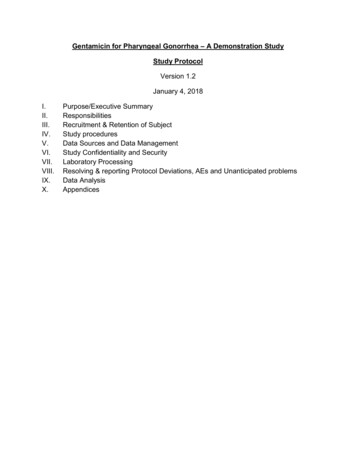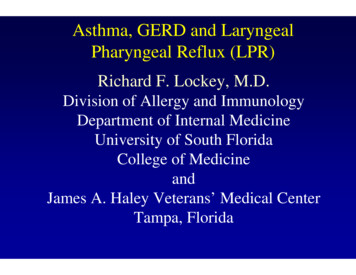
Transcription
Gentamicin for Pharyngeal Gonorrhea – A Demonstration StudyStudy ProtocolVersion 1.2January 4, ve SummaryResponsibilitiesRecruitment & Retention of SubjectStudy proceduresData Sources and Data ManagementStudy Confidentiality and SecurityLaboratory ProcessingResolving & reporting Protocol Deviations, AEs and Unanticipated problemsData AnalysisAppendices
Executive SummaryThe Centers for Disease Control and Prevention has identified antimicrobial-resistant (AMR)Neisseria gonorrhoeae (NG) as one of the nation’s top three urgent AMR threats. Since theadvent of antibiotics in the 1930s, NG has developed resistance to every first-line antibiotic.Parenteral third-generation cephalosporins are now the only class of drug with consistentefficacy against NG. New therapies are urgently needed. Although some novel antimicrobialsare under development, reevaluating older drugs is another option for quickly identifyingadditional treatments for gonorrhea. We propose a demonstration study to test a single doseof gentamicin for the treatment of pharyngeal gonorrhea. We chose to focus on pharyngealgonorrhea because these infections are common, play an important role in fosteringgonococcal resistance, and are harder to eradicate than genital infections. Althoughgentamicin is 91% efficacious for genital NG, its efficacy at the pharynx may be less sincestreptomycin, another aminoglycoside previously used to treat gonorrhea, was not effective forpharyngeal NG. It is unknown if streptomycin’s poor efficacy is indicative of limitations ofaminoglycosides as a class. We plan to enroll 60 men who have sex with men in ademonstration study to be conducted at the Seattle & King County STD Clinic to test theefficacy of 360 mg of gentamicin given intramuscularly for pharyngeal gonorrhea. Secondaryobjectives include determining the ideal pharmacodynamic criterion (comparing in vitro minimalinhibitory concentrations (MIC) of NG to peak gentamicin serum levels), estimating resistanceinduction among treatment failures, and assessing the tolerability of 360 mg of IM gentamicin.ObjectivesThe proposed study aims to evaluate the efficacy of a single intramuscular (IM) dose ofgentamicin in the treatment of pharyngeal gonorrhea. Secondary objectives includedocumenting the efficacy stratified by minimal inhibitory concentration (MIC) compared with thegentamicin peak level in order to estimate a pharmacodynamic criterion. We will also attemptto determine whether gentamicin monotherapy induces antimicrobial resistance amongtreatment failures. Lastly, we will evaluate the tolerability of 360 mg of IM gentamicin, stratifiedby subject weight (i.e. weight based dosing). The specific aims are:1) Determine the proportion of persons whose pharyngeal gonococcal infections are curedwith a single dose of 360mg gentamicin intramuscularly alone.2) Evaluate the renal safety and tolerability of 360mg IM of gentamicin.3) Document mean peak gentamicin levels following 360mg IM of gentamicin stratified byweight.4) Estimate the best pharmacodynamics criterion (i.e. peak/MIC ratio) for pharyngealgonorrhea treated with gentamicin using individual and mean peak gentamicin levelsand NG isolate MIC.5) Among treatment failures, conduct exploratory analyses comparing pre- and posttreatment MIC for evidence of induced resistance.Study Design: Prospective cohortStudy Population & Inclusion Criteria:Persons diagnosed with pharyngeal gonorrhea who are not yet treated
Exclusion criteria:Age less than 16 yearsReceipt of antibiotics in 30 daysKnown allergy to any aminoglycosideHistory of renal disease (including diagnosis of solitary kidney, chronic renalinsufficiency, renal cell carcinoma etc),Use of concurrent nephrotoxic drugs or muscle relaxantsHistory of diabetesHistory of hearing loss or tinnitusConcurrent infection with syphilis or chlamydiaPregnancy and/or nursingUnable to return for a follow-up visit 4-7 days ( /- 1 day).Study team’s discretionIntervention: 360mg IM gentamicin x 1Primary Outcome: Negative gonorrhea culture 4-7 days ( /- 1 day) after treatmentSample Size:60 personsStatistical Analysis Plan:The primary endpoint is the pharyngeal cure rate – that is, the proportion of subjects whoreturn for TOC who clear their infections as evidenced by a negative culture 4-7 ( /-1) daysafter treatment. Persons who test negative for NG at their enrollment visit (i.e. infectioncleared between initial clinical screening test and enrollment) will be excluded from analysis.Treatment failure will be defined as a positive culture 4-7 ( /-1) days after treatment. The curerate will be calculated as the number of cured subjects divided by the total number of subjectswho received treatment and returned for follow-up testing in a modified an intention to treat(mITT) analysis. We will also calculate the 95% CI for this proportion.We will conduct an interim analysis after we have primary outcome results for 25 subjects. Ifthe cure rate is 44% (99% CI 17% – 74%; i.e. 12 persons of 25 persons with a positiveculture on treatment date fail treatment), we will stop the study. We will also monitor for renaltoxicity at the interim analysis. We plan to obtain pre-treatment and post-treatment Creatinine.Increases 40% will be considered significant. If more than 20% of the study population has a 40% increase in serum Creatinine, we will halt the study. We chose 20% because if 20% ofsubjects experience renal toxicity it is unlikely to be due to chance (95% CI 7 – 40%).For our second objective, we will compare the MIC of cures to treatment failures using astratified approach (Table 2), and we will correlate this data with individual peak gentamicinlevel in order to estimate the ideal pharmacodynamic (PD) criterion (Obj. 2). For persons whofail treatment we will also compare the pre- and post-treatment genatmicin MIC to estimatewhether single dose gentamicin therapy can “induce” resistance (Obj. 3) as an exploratoryanalysis. We will consider an increase in the MIC by two doubling-dilutions (i.e. from MIC of 2to 8 µg/mL, or 8 to 32 µg/mL) to represent induced resistance, and we will calculate the
proportion of isolates among those that fail treatment that demonstrate induced resistancefollowing receipt of gentamicin. Lastly, we will report the number and proportion of subjectswho report side effects.We will evaluate subject’s tolerability (Obj. 4) using a standardized symptom questionnaireconducted at the TOC visit. The symptoms questioned will include, but not be limited to, rash,tinnitus, decreased hearing, nausea, vomiting, diarrhea, headaches, and decreased appetite.There will also be a section for free response.
ResponsibilitiesPrinciple Investigator:Lindley A. Barbee, MD MPHDepartment of Medicine, Division of Allergy and InfectiousDiseases, University of WashingtonStudy Coordinator:Angela LeClaireStudy Clinician:TBDMedical Monitor:Ann Collier, MDProfessor of Medicine, Division of Allergy and Infectious DiseasesUniversity of WashingtonDirector, UW AIDS Clinical Trials UnitAssociate Director, Center for AIDS ResearchUniversity of Washington and Fred HutchStudy Communication:Harborview Medical Center – STD clinic325 9th Ave, Box 359777Seattle, WA 98104Phone: (206) 744.2595Fax: (206) 744.4151Email: lbarbee@u.washington.eduStudy Site:Public Health – Seattle & King CountySTD Clinic908 Jefferson St, 11th FloorSeattle, WA 98104Phone: (206) 744.3590
Recruitment and Retention of SubjectsPatients who screen positive for pharyngeal gonorrhea, with or without concomitant GC atother anatomic sites, and have not yet received treatment for this infection or other antibioticsin the past 30 days are eligible for this study. We will not exclude based on gender or HIVstatus. Recruitment will primarily occur at PHSKC STD Clinic, however, we will also encouragehigh-diagnosing partner clinics to refer eligible patients as well. We plan to enroll 60 personswith untreated pharyngeal gonorrhea for this study.Recruitment at PHSKC STD Clinic:We will employ several strategies to recruit at PHSKC STD Clinic.1) Patients who screen positive for pharyngeal gonorrhea and are called with their testresults to return for treatment will be told on the phone that they may be eligible for atreatment study. (PHSKC STD Clinic providers (ie. ARNP, PA and/or RN) routinely callpatients with positive tests results, thus these clinical staff will tell patients about theireligibility for the study, however, PHSKC STD Clinic providers will not conduct formalstudy eligibility screening nor will they elaborate about study procedures (see script,Appendix A).) If patients indicate interest, the PHSKC provider will make anappointment for the patient with the study coordinator (for more information about thestudy, eligibility screening and enrollment procedures) and study clinician (for testingand treatment procedures) at their earliest convenience, ideally the next day.2) Some patient may not receive a phone call with test results prior to coming in fortreatment (i.e. they see results electronically on MyChart [patient portal] or they werenot informed of the study via a test results phone call, or were referred by an outsideclinic to the PHSKC STD Clinic for treatment as their provider does not stock therecommended therapy in their office). Patients who arrive at the PHSKC STD Clinic fortreatment of pharyngeal gonorrhea and have not yet been informed about the study willbe told by the triage RN or their clinician that they may be eligible and inquire abouttheir interest. If they indicate any interest in the study, they will be referred to the studycoordinator and/or study clinician at that time.Recruitment outside of PHSKC STD Clinic:We will advertise the Gentamicin Study with high diagnosing providers in thecommunity. Through a large CDC surveillance grant, SURRG, we already have arelationship with many of these providers: Madison Clinic, Dr. Shalit’s office, and CapitolHill Medical Group. We will inform providers in these clinics about the study andprovide study info cards (see Appendix B). When they diagnose a patient withuntreated pharyngeal gonorrhea, they will inform the patient that they may be eligible forthis study, and if the patient is interested, either the provider or patient can call the studycoordinator to set up an appointment.
Retention of subjects:This study consists of two study visits. Once enrolled, subjects need to return 4-7 days( /- 1day) for a test of cure (TOC) visit. At their enrollment visit, the subject will set up aTOC visit with either the study coordinator or study clinician, hand them an appointmentreminder card (see Appendix C). Less than 24 hours prior to the appointment, the studycoordinator will call the patient with an appointment reminder call. If the subject does notshow up for their appointment, the study coordinator will call them that day to set upanother TOC visit appointment.
Study ProceduresScreening & EnrollmentPre-screening will occur by the PHSKC STD Clinic RN who reviews all patients chartsto determine which services and provider(s) are warranted. Patients with untreatedpharyngeal gonorrhea will be referred to the study coordinator for screening. Screeningwill occur in person by the study coordinator, study clinician or PI. We will use astandardized screening eligibility form (see Appendix D) to determine patient’s eligibility.Since eligibility hinges on a diagnosis of untreated pharyngeal gonorrhea, for PHSKCSTD Clinic patients, we will ask the IRB for a waiver of consent to be able to pre-screencharts to access the subject’s medical record to confirm diagnosis prior to approachingthe patient. All other eligibility criteria will be based on self-report. Patient will beexcluded if they meet any of the following criteria: Age less than 16 yearsReceipt of antibiotics in 30 daysKnown allergy to any aminoglycosideHistory of renal disease (including diagnosis of solitary kidney, chronicrenal insufficiency, renal cell carcinoma etc),Use of concurrent nephrotoxic drugs or muscle relaxantsHistory of diabetesHistory of hearing loss or tinnitusConcurrent infection with syphilis or chlamydiaPregnancy and/or nursing (we will screen women not using highly activebirth control, i.e. OCPs, IUD or nexplanon, who are more than 28 daysfrom their last menstrual period)Unable to return for a follow-up visit 4-7 days ( /- 1 day).Study team’s discretionOnce it has been determined that the patient is eligible for and interested in the study,the study team member will go through the informed consent with the patient in detail.After the subject has signed the informed consent, formal study procedures will begin.1. Intake & Data Entry Form:The study coordinator or clinician will fill out the first section of the data entry form(see Appendix E) which includes subject contact information, demographicinformation (include sex assigned at birth, current gender identity, sexual orientation,race/ethnicity), HIV status, anatomic sites of infection, height, weight, concurrentmedications and medical history.2. Diagnostics and Baseline Clinical Data:
The study clinician will obtain specimens for culture from all anatomic sites that werescreen positive for gonorrhea. This will include the pharynx (by inclusion criteria) andpossibly the rectum, urethra and endocervix, per routine clinical care. A pharyngealspecimen is taken by gently touching a swab to the posterior aspect of the throatand moving it up and down, and over the tonsils for 5-10 seconds. Rectal swabsinvolved inserting a small q-tip like swab in the rectum approximately 3 cm andtwirling it around approximately five times. To obtain a urethral swabs, clinician use asmaller swab and insert it approximately 0.5 – 1 cm into the urethra and twirl 1-2times. Endocervical specimen collection requires a pelvic exam with speculum.Once the cervical os is visualized the clinician inserts the swab into the cervical
treatment (i.e. they see results electronically on MyChart [patient portal] or they were not informed of the study via a test results phone call, or were referred by an outside clinic to the PHSKC STD Clinic for treatment as their provider does not stock the recommended therapy in their office). Patients who arrive at the PHSKC STD Clinic for treatment of pharyngeal gonorrhea and have not yet .











